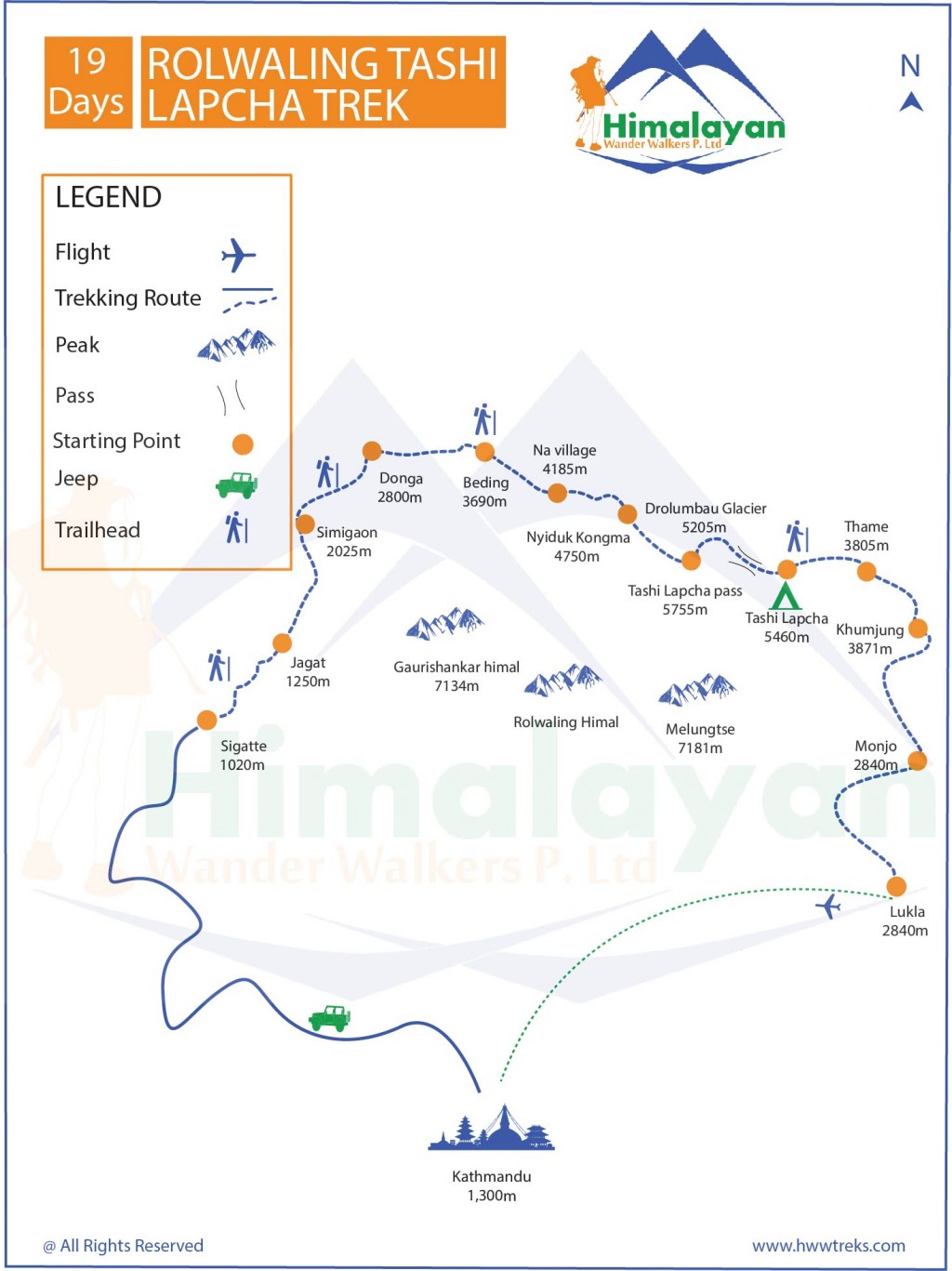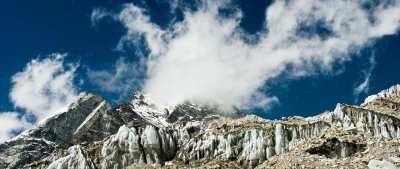Important Information
Region
Rolwaling Region Treks
Duration
19 Days
Max Altitude 5755m
Best Season April - October
Activity Per Day
5-6 hrs
Grade
Level 4
Group Size
2 - 12 people
Transportation Jeep
The Rolwaling valley is tucked between two impressive mountain ranges the Gaurishankar Himal and the Rolwaling Himal. The Rolwaling includes Melungtse (7181m) and Melungts II (2073m) both of which can be seen from Melunga – on the Tibetan side, and the Gaurishankar Himal includes Gaurishankar (7134m) on the Nepali side with some additional Peaks over 6000m. The Labuche Himal section rises beyond the Tama Koshi to the North West.
Rolwaling trek offers an outstanding view of the Himalayas that lies along the north eastern side of the finger land and that just form. Some of the highlights of this trek are Rolwaling valley, Tamang village, and wonderful views of Alpine lake, Hanging glaciers, moraines, high pastures, waterfalls, and imminent view of snowy peaks in the backdrop. This is a popular region for isolated villages, biological diversity, glacial lakes, and mountains. Rolwaling trek combines the view of Mt Melungtse, Mt Dorje, and Mt Tashi Lapcha, beautiful waterfalls, and the Tso Rolpa Lake.
In 2010 this area was declared a conservation area, known as the Gaurishankar conservation area: Covering 2179 square kilometers. It is home to 58000 people, the largest group being Tamangs followed by sherpas and Chetris. The trekkers will be rewarded with the enchanting views of majesty mount Gauri Shankar, many mysterious stories are been said about this valley. It is believed that Yeti lived over there. Numbers of tourist are increasing in this region because this trek provides us to see natural and cultural beauty of Nepal.
Highlights
- Explore the unmarked route of Gaurishankar
- Traversing the Tashi Lapcha La (5755m)
- Connecting the route to the Everest region
- Spectacular glacier view of Yalung and the Tso-Rolpa glacier lake.
- Great views of Mt. Melungtse (7181m), Mt. Dorje Lakpa and Mt. Gaurishankar.
If you are looking for a different itinerary than the itinerary here, please Customize Your Trip.
Include
Airport Arrivals and departure transport by car (We will collect you from the Kathmandu international airport) and transfer to Hotel.
Half-day sightseeing in Kathmandu (Boudhanath and Pasupatinath) with city guide and necessary transport.
3 nights’ accommodation (2 persons per room) in 3* hotel in Kathmandu with breakfast.
All land transportations (a private car/bus) mentioned in the itinerary
Full Camping trek with all meals and hot drinks during the trek serve by Cook and staff. Tented accommodation with dining, table, chairs, toilet tent, and shower tent. Salary, insurance, food, accommodation for guides, and porters. Supporters’ staff, cook, porters.
All required permits for trekking and Gaurshankar national park entry permits.
Group First Aid Kit.
Himalayan Wander Walkers Company Duffle Bag for luggage
Exclude
Meals & drinks during the trek and in Kathmandu (unless stated otherwise under ‘The trip cost includes’)
Personal trekking equipment
Travel/medical insurance
Emergency rescue evacuation
Phone calls
Internet
International air ticket
Tips for your trekking guide & porters at the end of the trek
If you’re forced to extend your trek due to bad weather or natural disaster circumstances, we are not liable to pay any compensation or otherwise be responsible for any expenses you may incur
Anything not mentioned in the ‘includes section’
Nepal entry visa Fee.
Route Map

Important Information
* The Price given here is per person based on a minimum of 2 pax. The price will be cheaper with an increase in the number of people.
* Single Supplement is applied (incase if you are single)
CHECKLISTS FOR ROLWALING TASHI LAPCHA TREK
- Valid passport (valid for six months from the date of your trip)
- MasterCard, Visa Credit, and Debit Cards are accepted in Nepal. However, some cash is highly recommended.
- Mobile (if your cell phone is from CINGULAR USA or ATNT (USA) operators, then your cell phone will work in Nepal.)
- Clothing (Layered clothes, windproof and waterproof jackets, fleece pullovers, thermal base layers, hiking pants, shorts, headwear, footwear, and other items according to your needs)
- Personal Items and Toiletries (First-Aid Kit, Iodine tablets or a UV purifier to treat water, Sun Protection)
- Travel and Health Insurance
- Trekking gear and equipment(if you have your own trekking gear and equipment, such as trekking poles, sleeping bag, and shoes, then you can bring them; else you can rent them in Thamel, Kathmandu). Read more for trekking gears and peak climbing gears.
Guiding, Food, and Camping
In Nepal, all trekking supplies - camping equipment, kitchen implements, food - are all carried by pack animals like mules, Yaks, and horses. Even Porters are common in Nepal. All trekkers are accompanied by a guide, a cook, and usually at least one horseman or yak herder. With the surest footing; they lead trekking groups across the passes. The horseman and cook will usually run ahead during a trekking day. They will have prepared a packed lunch for hikers and will go on to the night’s resting place to set up camp. They set up tents, cook dinner, and ready the area for arriving trekkers. When trekkers reach the campsite they are greeted with a hot cup of tea and biscuits in the dining tent. After six hours in the mountains, no drink will ever taste sweeter. For dinner, the cook will usually prepare a buffet of dishes that are as welcome as they are delicious.
DRESS CODE FOR VISITING MONASTERIES, AND TEMPLES
- Shirt (either half or full sleeve)
- Full pants/long skirts
- Any type of shoes with socks
- No Hats, No Umbrella, No Slippers, No t-shirts, No short skirt, and No half-pants
- Photographs allowed in the courtyard only.
Note regarding itineraries
Although we generally adhere to the schedule, the itinerary is subject to change for numerous reasons beyond our control, including weather and terrain conditions, suitable campsite availability, and the group's general fitness level. It is important to understand that our trek is logistically complex and it is not unusual that adjustments be made. Our guide will orient you each evening to the following day's plan; their good judgment is the key to the long history of successful treks that Himalayan Wander Walkers has led till now. Please remember that our ability to make adjustments as needed helps to ensure that your trek is successful.
Frequently Asked Question
Yes, you can customize the Rolwaling Tashi Lapcha Pass Trek according to your preferences. Whether you want to stop and spend a day or night in a specific location or tea house or you want to add a side trek, just let us know what you're looking for, and we’ll be happy to accommodate your wishes: “Customize Your Trip.”
The Rolwaling region lies in the Gaurishankar Conservation Area Project (GCAP) of central-east Nepal, between the Everest and Langtang Himalayan range, bordering Tibet.
The Tashi Lapcha Pass is 5753 meters (18820 ft) offering majestic views of surrounding mountains and peaks.
Rolwaling Tashi Lapcha Pass is a quite strenuous trek with high passes over 5000 meters. It might be quite unfeasible for beginners, as one needs to be physically prepared with a good amount of stamina and some mountaineering skills with ropes, climbing, and crampons.
Yes, you might get altitude sickness, as it is a common concern during the Tashi Lapcha Pass trek since it is at an elevation of 5753 meters. To help with acclimatization, the itinerary includes rest days at Na(4185 m) along with a hike to Yalung la. Staying hydrated, eating well, and ascending gradually are the best ways to prevent altitude sickness. If you experience symptoms like dizziness or headaches, inform your guide immediately so they can follow the necessary protocols.
For the Tashi Lapcha Pass trek, one needs to have the Lapche Restricted Permit, Gaurishankar Conservation Permit, Sagarmatha National Park, and the Pasang Lhamu Rural Municipality Fee. Some of these permits can be obtained from the Nepal Immigration Department through registered and authorized trekking agencies, whereas the Pasang Lhamu Rural Municipality Fee can be paid at the gate of Khumbhu Valley. Read more about trekking permits for the Rolwaling Region.
For the Tashi Lapcha Pass trek, Spring and autumn, i.e, from April to October, is the best season as there will be plenty of greenery along with stable weather and clear sky. During these seasons, there will be less risk of altitude sickness, and one will get to see the Rhododendrons along the routes. Read more about the best season for trekking in the Rolwaling region.
The cost of the Rolwaling Tashi Lapcha Pass trek starts from USD 2100 (all inclusive price) per person and depends on many factors including the season or time one chooses to trek, the mode of transportation, accommodations and lodging and many more. Read more about trekking costs in the Rolwaling region
For the Tashi Lapcha Pass trek, the essentials include sturdy trekking shoes, warm clothes, a sleeping bag, water bottles, sunscreen, a hat, and a small first-aid kit. Additionally, while passing or climbing through the pass, you need to have proper crampons, ropes, and other climbing gear. Be sure to pack light but adequately for the weather conditions and trek duration. Please visit our blog for more information on trekking gear and equipment.
No questions found matching your search. Try different keywords or browse all questions above.
| {{type.min}} - {{type.max}} Pax {{type.name}} - {{type.desc}} | {{type.display_price}} per people |
Extra prices:
Let us help you decide Inquiry
You might also like

- 8 days
- Rolwaling Region Treks
Lapchi Hermitage Trek
“Lapche valley Trek is one of the desirable trekking routes in the Himalayas of Nepal which is recommended by all travelers who had visited there.” Lapchi or Lapche is a paramount spiritual mountain which is known as the Milarepa’s hermitage. It is located in Rolwaling in the...
